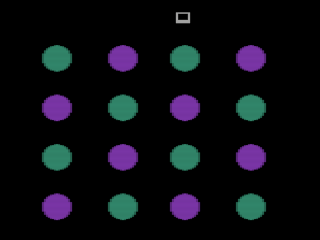Meltdown
|
Name:
|
Meltdown |
|
| Company: |
20th Century Fox |
|
Model #:
|
11029 |
|
Programmer:
|
David Ross |
| Year: |
1983 |
|
Released?
|
No
|
|
Notes:
|
Prototype
artwork exists |
Not to be confused with the Atari game by the same
name (which was released for the 7800), Meltdown was one
of the final 20th Century Fox titles to be developed but
was never released. Why TCF decided to cancel
Meltdown is unknown, but was most likely due to the
collapsing video game market. The decision to
cancel the game must have been made at the last moment,
as advertisements proudly boasting "Just Released" had
already been printed. Although Meltdown was
displayed at the 1983 CES show, it was never seen again
after the show closed. Long thought lost, Meltdown
surfaced in a resale shop in 2004 where by chance it was
discovered by a passing collector.
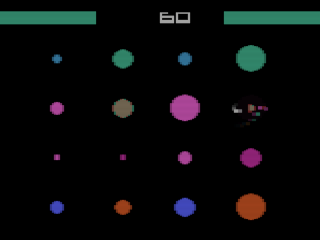
Meltdown is basically a game of hide and
seek that place on a 4x4 grid of atoms. At the start
of each round you will see a rogue quark move about the
reactor agitating the atoms. Each time the quark
touches one of atoms it will strip off some of the
electrons and atom will shrink. Once an atom has
lost all it's electrons it will become unstable and will
begin to glow. If all the atoms destabilize the
reactor will blow!
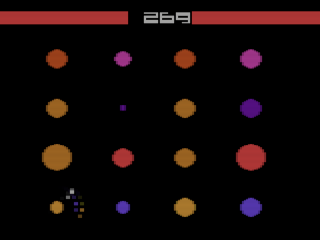
As the only remaining scientist, it is up
to you to destroy the quarks and cool down the reactor.
To accomplish this you will have to make use
of the only two tools at your disposal: an atomic
stabilizer and Cadmium rods. When the quark jumps to
an atom you must line up the stabilizer (on the X axis),
line up the Cadmium tube (on the Y axis), and quickly
insert a Cadmium rod by pressing the fire button.
However as soon as you destroy one quark another one
appears to take its place, so be vigilant and don't let
your guard down for a moment.
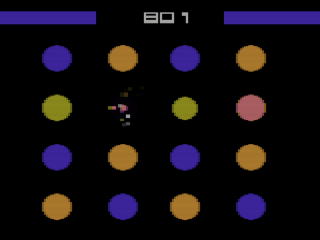
The core temperature is represented by a
bar displayed at the top of the screen. As the core
cools down, the bar will grow longer, once the bar reaches
the center of the screen the reactor will come back under
control and the reactor will be saved (for the moment).
Each time you successfully save the reactor the
action will get more intense; the number of quarks
will multiply, they will begin to move faster, and the
electrons will strip off more easily. Once you reach
the 10,000 mark, missing even one quark will likely blow
the reactor.
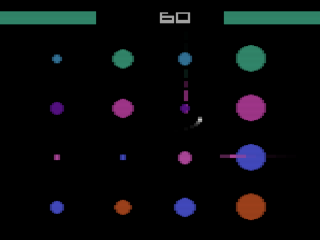
Meltdown uses both difficulty switches and
has fifteen different gameplay variations. The left
difficulty switch controls the penalty for firing on atoms
without the quark present (B = no penalty, A = the atom
will shrink) while the right switch controls whether or
not the quarks can wrap around the screen or are bound to
the grid (B = wraparound, A = no wraparound). The
various game variations generally set the starting
score/speed for the game, but there are some variations of
note. Games 6-10 feature auto alignment of the
Cadmium rod, meaning you only have to worry about moving
the atomic stabilizer around while Games 11-15 are two
player variations. With so many different variations
and options to choose from, the player can easily adjust
the gameplay to their skill level (special thanks to
Omegamatrix for this information!).
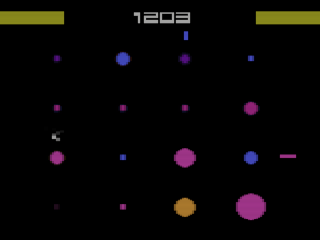
Meltdown is an simple, yet amazingly
addictive game. It's interesting graphical style and
progressive difficulty ramping makes Meltdown a game
that's hard to put down. It's a shame that 20th
Century Fox never released Meltdown as it is one of their
better titles, but such was the fate of many prototypes.
Like most TCF games, Meltdown was not developed by
Fox themselves, but rather by a small company called
Videa. Videa eventually became Sente Technologies
before being acquired by Bally and becoming the well known
Bally Sente.
Meltdown
Advertisement (courtesy of Atari Gaming
Headquarters)
| Version |
Cart Text |
Description |
| ?????? |
Meltdown |
Final Version? |
Return
to 2600 Software
|

